【2013年名师最新原创】高考英语二轮复习精品课件:非谓语动词课件(全国通用)
文档属性
| 名称 | 【2013年名师最新原创】高考英语二轮复习精品课件:非谓语动词课件(全国通用) |  | |
| 格式 | zip | ||
| 文件大小 | 294.5KB | ||
| 资源类型 | 教案 | ||
| 版本资源 | |||
| 科目 | 英语 | ||
| 更新时间 | 2013-04-07 17:21:59 | ||
图片预览

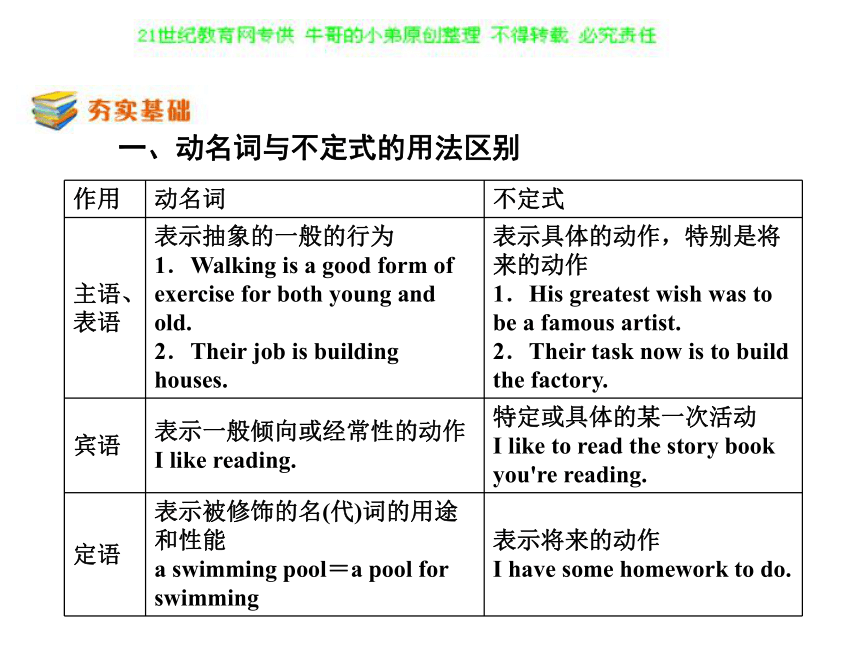
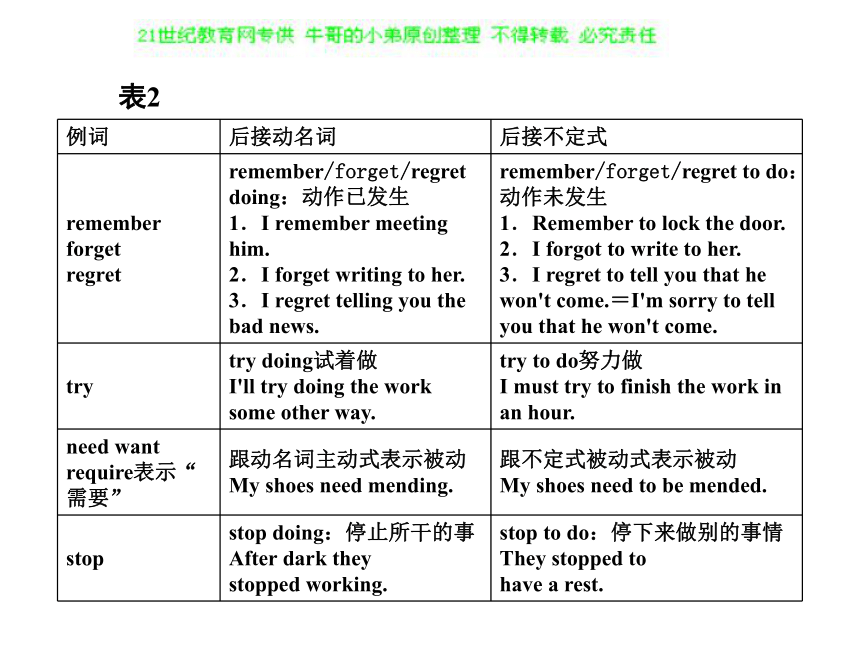
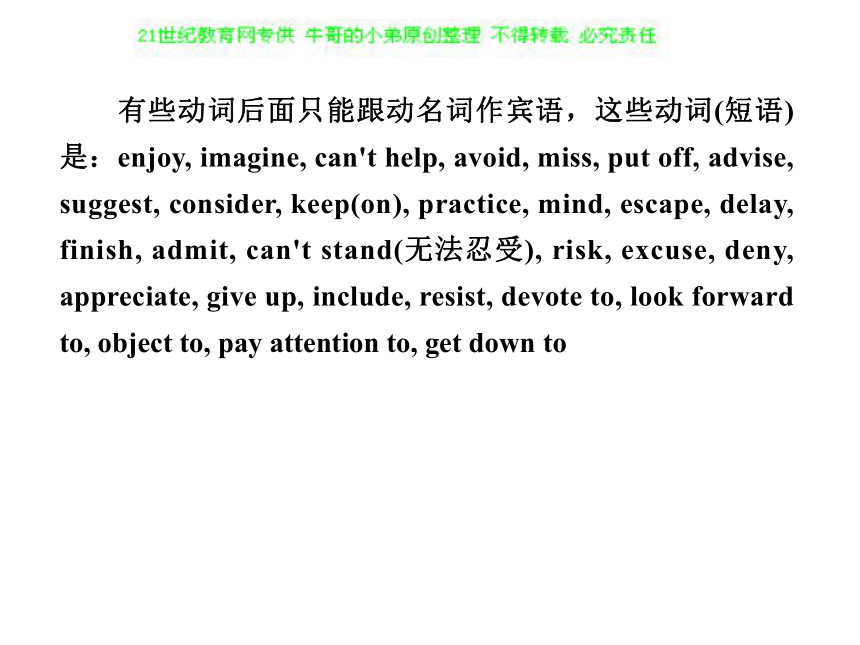
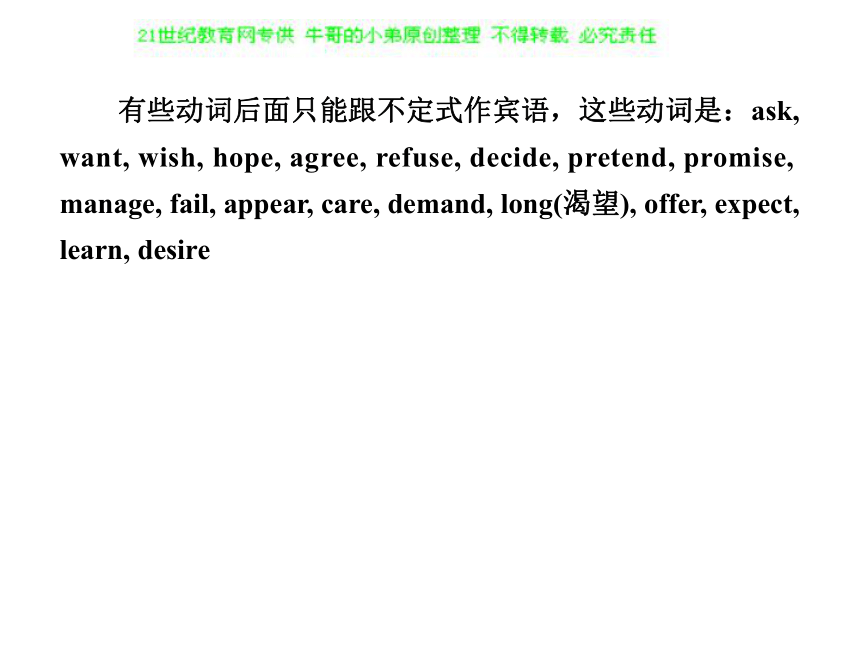
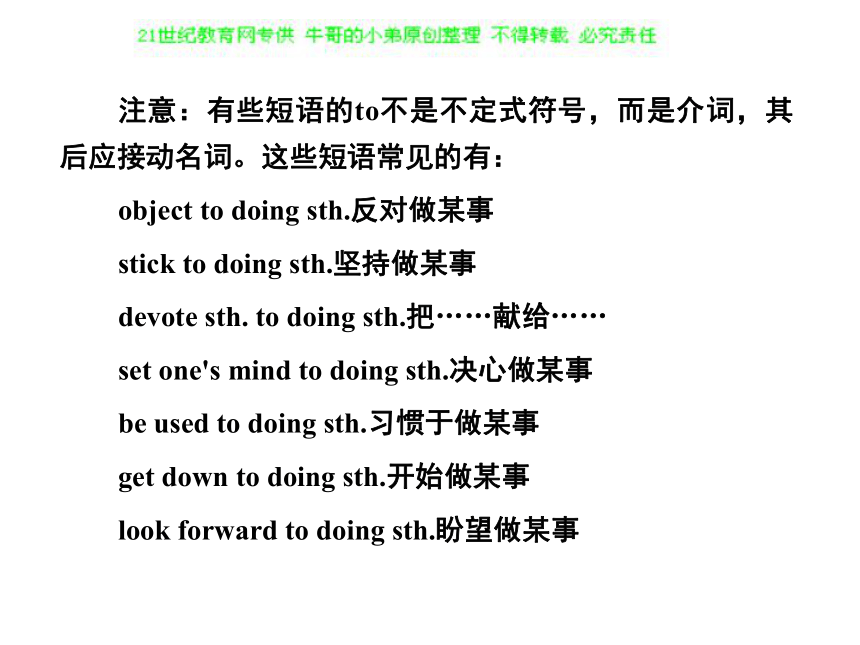
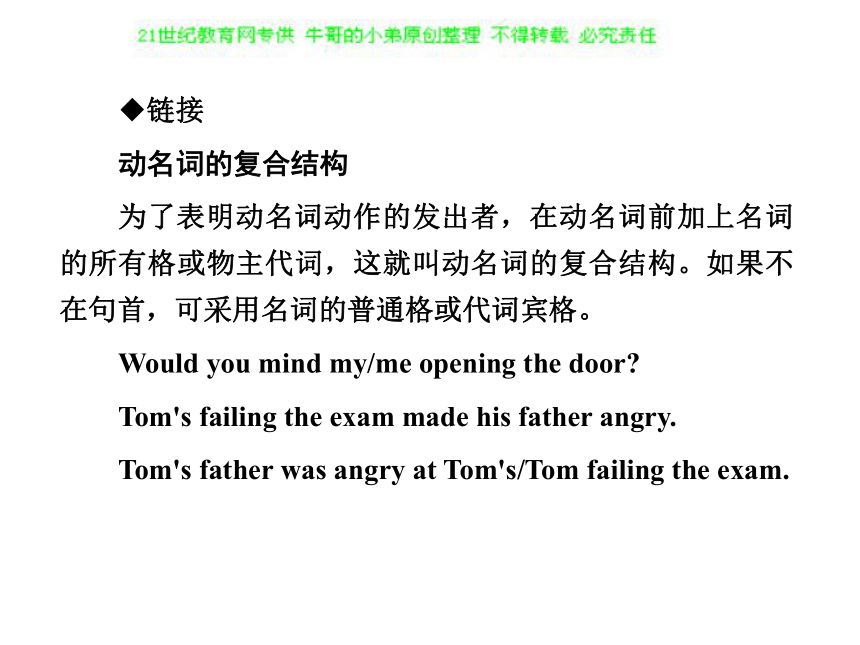
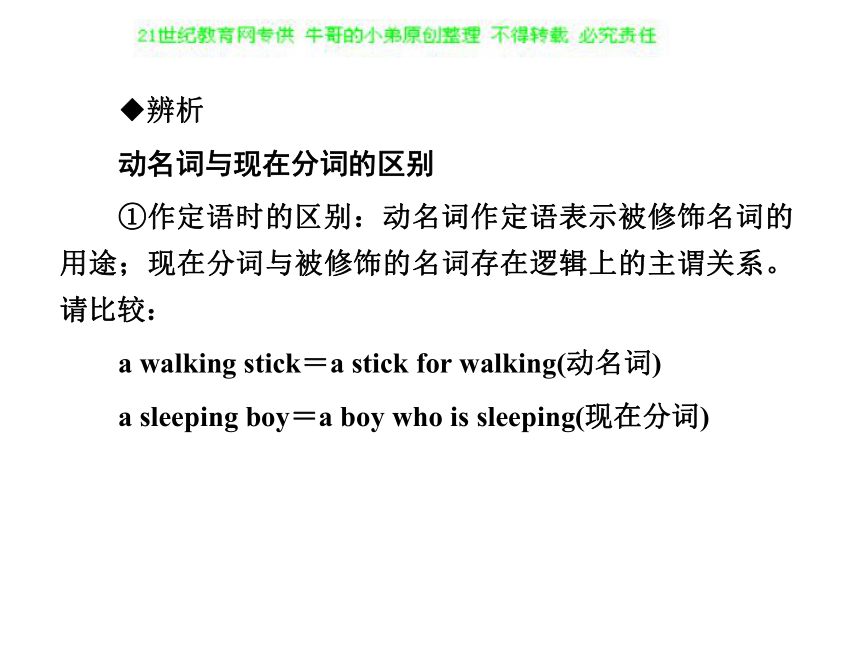
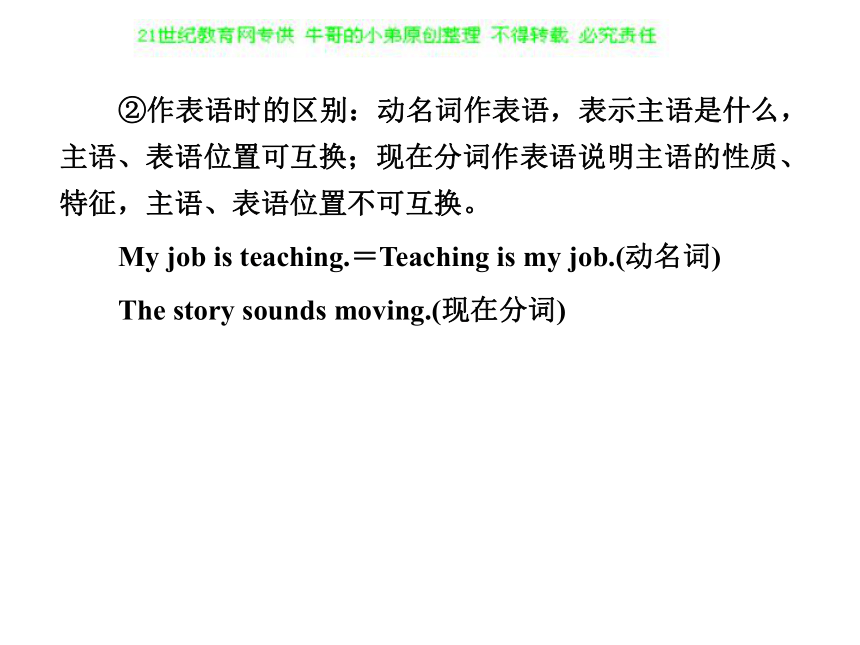
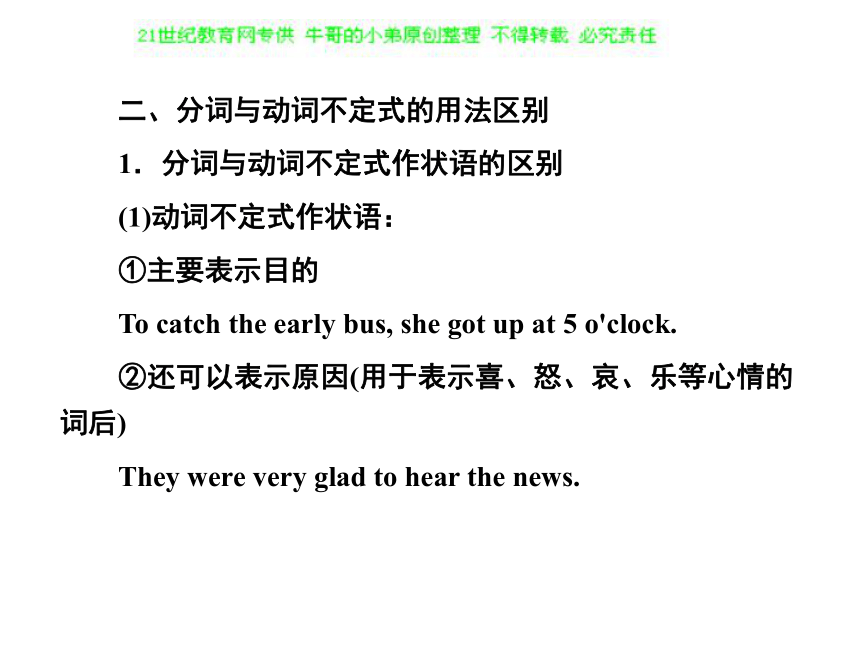
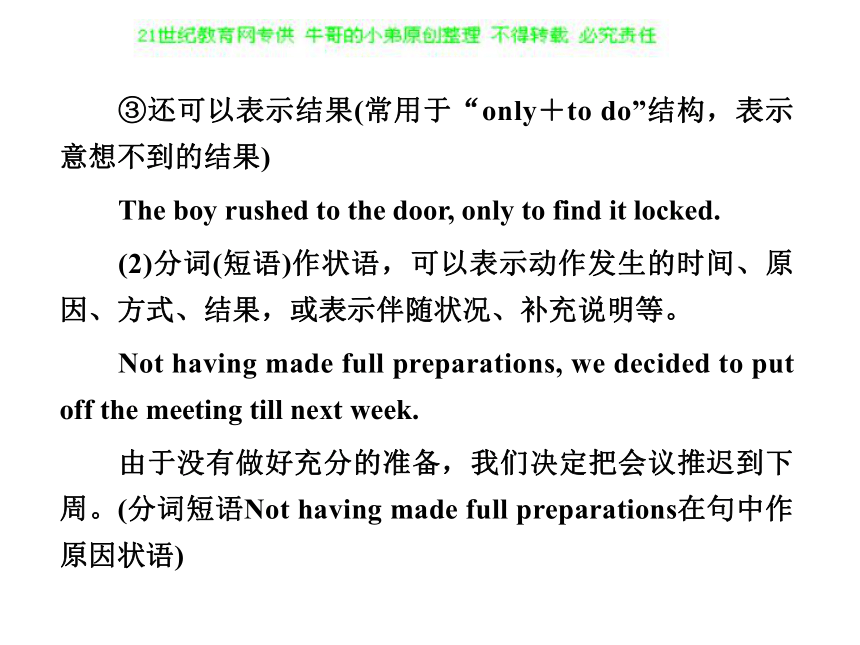

文档简介
课件49张PPT。
高考英语二轮复习:非谓语动词课件一、动名词与不定式的用法区别表2有些动词后面只能跟动名词作宾语,这些动词(短语)是:enjoy, imagine, can't help, avoid, miss, put off, advise, suggest, consider, keep(on), practice, mind, escape, delay, finish, admit, can't stand(无法忍受), risk, excuse, deny, appreciate, give up, include, resist, devote to, look forward to, object to, pay attention to, get down to有些动词后面只能跟不定式作宾语,这些动词是:ask, want, wish, hope, agree, refuse, decide, pretend, promise, manage, fail, appear, care, demand, long(渴望), offer, expect, learn, desire注意:有些短语的to不是不定式符号,而是介词,其后应接动名词。这些短语常见的有:
object to doing sth.反对做某事
stick to doing sth.坚持做某事
devote sth. to doing sth.把……献给……
set one's mind to doing sth.决心做某事
be used to doing sth.习惯于做某事
get down to doing sth.开始做某事
look forward to doing sth.盼望做某事◆链接
动名词的复合结构
为了表明动名词动作的发出者,在动名词前加上名词的所有格或物主代词,这就叫动名词的复合结构。如果不在句首,可采用名词的普通格或代词宾格。
Would you mind my/me opening the door?
Tom's failing the exam made his father angry.
Tom's father was angry at Tom's/Tom failing the exam.◆辨析
动名词与现在分词的区别
①作定语时的区别:动名词作定语表示被修饰名词的用途;现在分词与被修饰的名词存在逻辑上的主谓关系。请比较:
a walking stick=a stick for walking(动名词)
a sleeping boy=a boy who is sleeping(现在分词)②作表语时的区别:动名词作表语,表示主语是什么,主语、表语位置可互换;现在分词作表语说明主语的性质、特征,主语、表语位置不可互换。
My job is teaching.=Teaching is my job.(动名词)
The story sounds moving.(现在分词)二、分词与动词不定式的用法区别
1.分词与动词不定式作状语的区别
(1)动词不定式作状语:
①主要表示目的
To catch the early bus, she got up at 5 o'clock.
②还可以表示原因(用于表示喜、怒、哀、乐等心情的词后)
They were very glad to hear the news.③还可以表示结果(常用于“only+to do”结构,表示意想不到的结果)
The boy rushed to the door, only to find it locked.
(2)分词(短语)作状语,可以表示动作发生的时间、原因、方式、结果,或表示伴随状况、补充说明等。
Not having made full preparations, we decided to put off the meeting till next week.
由于没有做好充分的准备,我们决定把会议推迟到下周。(分词短语Not having made full preparations在句中作原因状语)Hearing the news, he burst into tears.
听到这个消息,他突然哭了起来。(现在分词短语hearing the news在句中作时间状语,意思是“当他听到这个消息时”)
When asked what had happened, he told us the whole thing.
当被问到发生了什么事情时,他向我们和盘托出。
Laughing and talking, they went into the room.
他们说笑着进了屋。(分词短语laughing and talking表明他们进屋的方式)Armed with a raincoat and an umbrella, he set out to search for the lost child.
穿着雨衣,拿着雨伞,他出发去寻找那个丢失的孩子了。(过去分词短语armed with a raincoat and an umbrella表明他出发时的方式)
Football is played in 80 countries, making it the most popular sport in the world.
80个国家都踢足球,使得足球成为世界上最为流行的运动。(分词短语making...in the world从意义上讲是“80个国家都踢足球”的结果)He sat there, thinking.
他坐在那里,沉思着。(“沉思”伴随着“坐”)
The professor entered the lab, followed by his assistants.
那位教授进了实验室,后面跟着他的助手们。
The visiting Minister expressed his satisfaction with the talks, adding that he had enjoyed his stay here.(分词adding that...从意义上讲是对句中的expressed his satisfaction的补充说明)
Turning left, you will find the cinema.
=If you turn left, you will find the cinema.(表条件)
Though lacking money, his parents managed to send him to university.
尽管缺钱,他的父母还是送他上了大学。(表让步)◆技巧
解题时,根据句意弄清楚空白处需要哪一种状况是关键。如果表示目的,就要用不定式;如果表示时间、条件、方式、让步、原因、伴随状况等,就要用分词。
◆辨析
现在分词与过去分词作状语时的区别:
现在分词表示主动;过去分词表示被动。①Seeing nobody at home, he left them a note.(句子主语he与动词see之间为主谓关系,因此用现在分词)
②Seen from the top of the building, the city looks beautiful.(the city与动词see之间为动宾关系,因此用过去分词)典例 (天津,12)______into English, the sentence was found to have an entirely different word order.
A.Translating B.Translated
C.To translate D.Having translated
解析:B。本题考查动词的非谓语形式作状语。主句主语the sentence与 translate之间为逻辑上的动宾关系,故应用过去分词形式表示被动意义,A、C、D三项均表示主动意义。句意:被翻译成英语后,我们发现这个句子的顺序完全不一样了。 2.分词与动词不定式作定语、表语、宾语补足语的区别作定语比较:
(1)Did you know the girl talking to our English teacher?(主动、进行)
(2)The bridge built last week cost one million dollars.(被动、完成)
(3)We live in a house facing south.(只表主动)
(4)He likes to read novels written by Dickens.(只表示被动)
(5)He is a retired worker.(不及物动词的过去分词只表示完成)
(6)I have an article to write.(不定式表示将来)典例 (山东卷,27)Look over there—there's a very long, winding path________up to the house.
A. leading B. leads
C. led D. to lead
解析:A。本题考查非谓语动词作定语。句意:看那儿——有一条很长的且蜿蜒曲折的路,它直接通向这座房子。本题为非谓语动词作定语,故排除B项,且path与lead之间为主谓关系,故用现在分词作定语。作表语比较:
(1)The story is interesting.(表示主语的特征)
(2)He was excited at the news.(表示主语所处的状态)
(3)His job is to look after patients.(表示主语的具体内容)
作宾语补足语比较:
(1)Can you hear her singing in the next room?(表示正在进行的动作)(2)I often hear the song sung in English.(表示被动、完成的动作)
(3)I often hear her sing the song.(表示主动和全部过程)
◆技巧
解题思路
贯彻“八字方针”:根据语境,分析关系。分述如下:
①作定语时,分析被修饰语和非谓语动词之间的关系:主谓关系用现在分词;动宾关系用过去分词;表示将来的动作用动词不定式。
②作宾语补足语时,分析宾语和宾语补足语之间的关系:表示主动、正在进行的动作用现在分词;表示被动、已经完成的动作用过去分词;表示将来的动作用动词不定式。典例 (·新课标卷,27)The next thing he saw was smoke ________ from behind the house.
A.rose B.rising
C.to rise D.risen
解析:B。本题考查非谓语动词的用法。句意:他看到的下一件事情是从房后冒出的烟。根据句子结构可知,此处缺少定语。故排除A项。B项为现在分词,且smoke与rise之间为主谓关系,符合语境。而C项为不定式表将来,D项为过去分词,表完成,都不符合语境。◆警示
特别注意:英语中有12个动词后面跟不定式作宾语补足语时不带to。它们是:
五“看”:see, look at, watch, notice, observe
二“听”:hear, listen to
一“感”:feel
三“让”:have, let, make
一“帮”:help(其后作宾语补足语的不定式可带to也可不带to)
但变为被动语态时必须加to。三、谓语动词与非谓语动词
在非谓语动词的学习中,经常会出现谓语动词与非谓语动词使用混乱的情况。以下四个句子是非谓语动词使用中的一些典型错误:
1.It was unbelievable that the fans waited outside the gym for three hours just had a look at the sports stars.
2.She set out after dark arriving home an hour later.
3.Using your head, and you will find a way.
4.Having been told many times, but he still made a lot of mistakes.以上句子应改正如下:
1.把had改为to have。很难想象那些粉丝在体育馆外等待三个小时仅仅是为了看那些体育明星。不定式短语to have a look at the sports stars在句中作目的状语。
2.把arriving改为and arrived, arrived与set out构成并列谓语。arrived与set out为先后发生的两个动作,作并列谓语,因此用谓语动词。判断的方法1:并列作谓语时用谓语动词形式;非谓语动词是对谓语动词进行说明的(说明谓语动词表示的动作发生的时间、条件、原因、方式或者是伴随动作等)。
3.把Using改为Use。此句构成“祈使句+and+陈述句”结构(句子表示一种条件关系)。或把and去掉,using...作状语,use与主语you为主动关系,所以用现在分词。
4.把分词短语Having been told many times改为句子He had been told many times,因为句中有连词but,前后构成并列句,因此要用谓语动词。另外,此句也可以把but去掉,Having been told many times在句中作时间状语。判断的方法2:要正确选用谓语动词与非谓语动词,考生还必须学会准确把握句子结构(特别注意句中的连词)。根据句子结构,判断应该使用谓语动词还是非谓语动词。
◆探究
高考试题命题特点:
选项中给出某个动词的谓语动词和非谓语动词形式,考查考生区分谓语动词与非谓语动词的能力。典例 (·浙江卷,3)Bats are surprisingly long-lived creatures, some ________ a life span of around 20 years.
A.having B.had
C.have D.to have
解析:A。考查独立主格结构。句意:蝙蝠是一种令人吃惊的长寿生物,有些有大约20年的寿命。逗号前是一个简单句,两部分之间没有连词过渡,所以空白处需采用非谓语形式,排除C项;且与其逻辑主语some存在主动关系,排除B项;另外该动作描述事实的存在现象,故排除D项,选择A项。四、to be done, done, being done的区别
done,过去分词;
to be done,不定式的被动式,表示将来,不作谓语,是非谓语动词;
being done,动名词的被动式或者是现在分词的被动式。
这三者作定语都表示被动,但表示的时间不同:
表示已经发生的动作用done;
表示将要发生的动作用to be done;
表示正在进行的动作用being done。如:
the bridge built已经建成的桥
the bridge to be built将要建的桥
the bridge being built正在建的桥◆技巧
解题时要判断出动作发生的时间,紧紧抓住句中的时间状语,此乃解题的关键。
五、动词-ing与动词-ed的区别(两种形容词化的分词的区别)
英语中,有些动词的分词形式已经转化为形容词,如:
excite使兴奋—exciting令人兴奋的—excited感到兴奋的
surprise使惊奇—surprising令人惊奇的—surprised感到惊奇的
interest使感兴趣—interesting令人感兴趣的—interested感兴趣的判断的方法:当表示主语具有某种特征或性质时,即“令人……的”用动词-ing;而当表示主语处于某种状态时,即“感到……的”就用动词-ed。
◆警示
有些考生认为,动词-ing用来说明物,而动词-ed用来说明人,其实这并不确切。
Jack failed in the exam, and his father was disappointed with Jack. He thought Jack was disappointing.
真正的规律是:
当表示“令人……的”时用动词-ing,而当表示“感到……的”时用动词-ed。六、使用非谓语动词的“一致性”问题
请先观察以下几个句子:
1.While looking at the map, a police officer came up and asked if he could help me.
2.Being a fine day, the children went to the park.
3.Arriving at the station, Tom's wallet was stolen.
以上三个句子都是错误的,犯了“逻辑不一致”的错误。因为非谓语动词作状语,其逻辑主语必须与句子主语保持一致。因此,当前后主语一致时,可以使用非谓语动词作状语;如果前后主语不一致,则要用独立主格结构或从句。以上三句依据“一致原则”可改为:1.依题意可知,looking的逻辑主语应为I,与句子的主语不一致,因此应在looking前加I was。
2.Being a fine day的逻辑主语为it指代天气,与句子的主语不一致,因此在句首加It, Being的首字母改为小写。
3.Arriving at the station的逻辑主语是Tom,与句子的主语不一致。此句可以改为:When Tom arrived at the station, his wallet was stolen.◆链接
有些非谓语动词作状语时,其逻辑主语可以不与句子的主语保持一致,被称为“独立成分”。这类独立成分有:
generally/exactly/strictly speaking(一般来讲/准确地说/严格来说), judging by/from(根据……来判断), considering(考虑到……), to tell (you) the truth(说实话), to be honest(说实话)。
①To be honest, we don't think we have a chance of winning.
说实话,我认为我们没有获胜的希望。②Strictly speaking, he is not old enough to take part in the game.
严格地讲,他还不到参加比赛的年龄。
③Considering the high quality, our price is very reasonable.
鉴于产品的优良质量,我们的价格非常合理。七、不定式何时用主动表被动
下列情况下不定式用主动形式表示被动意义:
1.在“主语+系动词+表语+to do”结构中,如果句子的主语是do逻辑上的宾语,不定式用主动形式。
The problem is difficult to solve.
这个问题很难解决。
English is not easy to learn.
英语不容易学。2.不定式作定语,与被修饰词之间为动宾关系,而与句中的另一名词或代词之间有主谓关系时(即在句子中能够找到该不定式动作的逻辑主语时),用主动式。但如果没有这种主谓关系,则需要用不定式的被动形式。
I can't go with you; I have a meeting to attend.(不定式短语中的动词attend与被修饰词meeting之间为动宾关系,而与句中的另一代词即句子的主语I之间为主谓关系,因此不定式用主动形式)3.在“疑问词+不定式”结构中。
I don't know what to do.
She will tell you which bus to take.
她会告诉你坐哪路公共汽车的。◆链接
不定式用主动表被动的其他情况:
①在“形容词+不定式”结构作宾语补足语时。
I find the question difficult to answer.
我发现这个问题很难回答。
②在“too...to...”结构中。
The box is too heavy for the boy to carry.◆警示
不定式作定语时,如果不定式中的动词与句子的主语构成动宾关系,且不定式中的动词是一个不及物动词,那么其后必须加上适当的介词。
The chair is comfortable to sit on.
这把椅子坐起来很舒服。
He is easy to get on with.
他是一个容易相处的人。
The river is dangerous to swim in.
在这条河里游泳很危险。典例 (·福建卷,27)The difference in thickness and weight from the earlier version makes the Ipad 2 more comfortable______.
A.held B.holding
C.be held D.to hold
解析:D。本题考查非谓语动词。句意:与前一个版本厚度与重量的不同使得Ipad2握起来更舒服。分析结构可知,hold与宾语Ipad2之间为动宾关系,但与其逻辑主语之间为主谓关系,故用不定式的主动形式作定语。【2012重庆卷】28. We’re having a meeting in half an hour. The decision ______ at the meeting will in the future of our company.
A. to be made B. being made C. made D. having been made
28.【考点】非谓语动词
【答案】 A
【解析】分析句子结构可知,空白处为后置定语,与被修饰的名词是逻辑上的被动关系,而且是将要发生的动作。由此可知,表示被动和将来的A选项符合题意。B表示被动进行,C表示被动完成,D表示被动完成,但是不作定语。因此,正确答案为A选项。
【难度】困难【2012重庆卷】23.______to work overtime that evening, I missed a wonderful film.
A. Having been asked B. To ask
C. Having asked D. To be asked
23.【考点】非谓语动词用法
【答案】A
【解析】逗号前为原因状语,空白处与句子的主语为逻辑上的动宾关系,由此可排除表示主动关系的B和C选项,D选项常作目的和结果状语,不作原因状语,也可排除,而A选项为现在分词完成式的被动形式,可作时间状语、原因状语、结果状语、伴随状语等。因此,正确答案为A选项。
【难度】一般【2012辽宁卷】29. This machine is very easy . Anybody can learn to use it in a few minutes.
A. operating B. to be operating
C. operated D. to operate
29、【考点】非谓语动词
【答案】D
【解析】在句型“主语+be+adj+to do”中,如果这个主语是动词do的逻辑宾语,故用主动表被动,所以选D。
【难度】较难【2012四川卷】12. Before driving into the city, you are required to get your car ____.
A. washed B. wash C. washing D. to wash
12.【答案与解析】 A 本题考查非谓语动词。考查过去分词作宾语补足语。此题中使役动词get后接的宾语car与作宾语补足语的动词wash之间为被动关系,构成短语:get sth. done。故答案选A。句意为:在驱车进城之前,你必须将你的车洗了。【2012陕西卷】15.________ in a long queue, we waited for the store to open to buy a New iPad .
A. Standing B. To stand
C. Stood D. Stand
[2012陕西卷]【答案与解析】A 考查非谓语动词。非谓语动词短语后有逗号,说明非谓语动词做题干的状语,逻辑主语是句子的主语we,非谓语动词与逻辑主语是主动关系,且其动作与谓语动词wait的动作同时进行,用动词v-ing的一般式,选A。
高考英语二轮复习:非谓语动词课件一、动名词与不定式的用法区别表2有些动词后面只能跟动名词作宾语,这些动词(短语)是:enjoy, imagine, can't help, avoid, miss, put off, advise, suggest, consider, keep(on), practice, mind, escape, delay, finish, admit, can't stand(无法忍受), risk, excuse, deny, appreciate, give up, include, resist, devote to, look forward to, object to, pay attention to, get down to有些动词后面只能跟不定式作宾语,这些动词是:ask, want, wish, hope, agree, refuse, decide, pretend, promise, manage, fail, appear, care, demand, long(渴望), offer, expect, learn, desire注意:有些短语的to不是不定式符号,而是介词,其后应接动名词。这些短语常见的有:
object to doing sth.反对做某事
stick to doing sth.坚持做某事
devote sth. to doing sth.把……献给……
set one's mind to doing sth.决心做某事
be used to doing sth.习惯于做某事
get down to doing sth.开始做某事
look forward to doing sth.盼望做某事◆链接
动名词的复合结构
为了表明动名词动作的发出者,在动名词前加上名词的所有格或物主代词,这就叫动名词的复合结构。如果不在句首,可采用名词的普通格或代词宾格。
Would you mind my/me opening the door?
Tom's failing the exam made his father angry.
Tom's father was angry at Tom's/Tom failing the exam.◆辨析
动名词与现在分词的区别
①作定语时的区别:动名词作定语表示被修饰名词的用途;现在分词与被修饰的名词存在逻辑上的主谓关系。请比较:
a walking stick=a stick for walking(动名词)
a sleeping boy=a boy who is sleeping(现在分词)②作表语时的区别:动名词作表语,表示主语是什么,主语、表语位置可互换;现在分词作表语说明主语的性质、特征,主语、表语位置不可互换。
My job is teaching.=Teaching is my job.(动名词)
The story sounds moving.(现在分词)二、分词与动词不定式的用法区别
1.分词与动词不定式作状语的区别
(1)动词不定式作状语:
①主要表示目的
To catch the early bus, she got up at 5 o'clock.
②还可以表示原因(用于表示喜、怒、哀、乐等心情的词后)
They were very glad to hear the news.③还可以表示结果(常用于“only+to do”结构,表示意想不到的结果)
The boy rushed to the door, only to find it locked.
(2)分词(短语)作状语,可以表示动作发生的时间、原因、方式、结果,或表示伴随状况、补充说明等。
Not having made full preparations, we decided to put off the meeting till next week.
由于没有做好充分的准备,我们决定把会议推迟到下周。(分词短语Not having made full preparations在句中作原因状语)Hearing the news, he burst into tears.
听到这个消息,他突然哭了起来。(现在分词短语hearing the news在句中作时间状语,意思是“当他听到这个消息时”)
When asked what had happened, he told us the whole thing.
当被问到发生了什么事情时,他向我们和盘托出。
Laughing and talking, they went into the room.
他们说笑着进了屋。(分词短语laughing and talking表明他们进屋的方式)Armed with a raincoat and an umbrella, he set out to search for the lost child.
穿着雨衣,拿着雨伞,他出发去寻找那个丢失的孩子了。(过去分词短语armed with a raincoat and an umbrella表明他出发时的方式)
Football is played in 80 countries, making it the most popular sport in the world.
80个国家都踢足球,使得足球成为世界上最为流行的运动。(分词短语making...in the world从意义上讲是“80个国家都踢足球”的结果)He sat there, thinking.
他坐在那里,沉思着。(“沉思”伴随着“坐”)
The professor entered the lab, followed by his assistants.
那位教授进了实验室,后面跟着他的助手们。
The visiting Minister expressed his satisfaction with the talks, adding that he had enjoyed his stay here.(分词adding that...从意义上讲是对句中的expressed his satisfaction的补充说明)
Turning left, you will find the cinema.
=If you turn left, you will find the cinema.(表条件)
Though lacking money, his parents managed to send him to university.
尽管缺钱,他的父母还是送他上了大学。(表让步)◆技巧
解题时,根据句意弄清楚空白处需要哪一种状况是关键。如果表示目的,就要用不定式;如果表示时间、条件、方式、让步、原因、伴随状况等,就要用分词。
◆辨析
现在分词与过去分词作状语时的区别:
现在分词表示主动;过去分词表示被动。①Seeing nobody at home, he left them a note.(句子主语he与动词see之间为主谓关系,因此用现在分词)
②Seen from the top of the building, the city looks beautiful.(the city与动词see之间为动宾关系,因此用过去分词)典例 (天津,12)______into English, the sentence was found to have an entirely different word order.
A.Translating B.Translated
C.To translate D.Having translated
解析:B。本题考查动词的非谓语形式作状语。主句主语the sentence与 translate之间为逻辑上的动宾关系,故应用过去分词形式表示被动意义,A、C、D三项均表示主动意义。句意:被翻译成英语后,我们发现这个句子的顺序完全不一样了。 2.分词与动词不定式作定语、表语、宾语补足语的区别作定语比较:
(1)Did you know the girl talking to our English teacher?(主动、进行)
(2)The bridge built last week cost one million dollars.(被动、完成)
(3)We live in a house facing south.(只表主动)
(4)He likes to read novels written by Dickens.(只表示被动)
(5)He is a retired worker.(不及物动词的过去分词只表示完成)
(6)I have an article to write.(不定式表示将来)典例 (山东卷,27)Look over there—there's a very long, winding path________up to the house.
A. leading B. leads
C. led D. to lead
解析:A。本题考查非谓语动词作定语。句意:看那儿——有一条很长的且蜿蜒曲折的路,它直接通向这座房子。本题为非谓语动词作定语,故排除B项,且path与lead之间为主谓关系,故用现在分词作定语。作表语比较:
(1)The story is interesting.(表示主语的特征)
(2)He was excited at the news.(表示主语所处的状态)
(3)His job is to look after patients.(表示主语的具体内容)
作宾语补足语比较:
(1)Can you hear her singing in the next room?(表示正在进行的动作)(2)I often hear the song sung in English.(表示被动、完成的动作)
(3)I often hear her sing the song.(表示主动和全部过程)
◆技巧
解题思路
贯彻“八字方针”:根据语境,分析关系。分述如下:
①作定语时,分析被修饰语和非谓语动词之间的关系:主谓关系用现在分词;动宾关系用过去分词;表示将来的动作用动词不定式。
②作宾语补足语时,分析宾语和宾语补足语之间的关系:表示主动、正在进行的动作用现在分词;表示被动、已经完成的动作用过去分词;表示将来的动作用动词不定式。典例 (·新课标卷,27)The next thing he saw was smoke ________ from behind the house.
A.rose B.rising
C.to rise D.risen
解析:B。本题考查非谓语动词的用法。句意:他看到的下一件事情是从房后冒出的烟。根据句子结构可知,此处缺少定语。故排除A项。B项为现在分词,且smoke与rise之间为主谓关系,符合语境。而C项为不定式表将来,D项为过去分词,表完成,都不符合语境。◆警示
特别注意:英语中有12个动词后面跟不定式作宾语补足语时不带to。它们是:
五“看”:see, look at, watch, notice, observe
二“听”:hear, listen to
一“感”:feel
三“让”:have, let, make
一“帮”:help(其后作宾语补足语的不定式可带to也可不带to)
但变为被动语态时必须加to。三、谓语动词与非谓语动词
在非谓语动词的学习中,经常会出现谓语动词与非谓语动词使用混乱的情况。以下四个句子是非谓语动词使用中的一些典型错误:
1.It was unbelievable that the fans waited outside the gym for three hours just had a look at the sports stars.
2.She set out after dark arriving home an hour later.
3.Using your head, and you will find a way.
4.Having been told many times, but he still made a lot of mistakes.以上句子应改正如下:
1.把had改为to have。很难想象那些粉丝在体育馆外等待三个小时仅仅是为了看那些体育明星。不定式短语to have a look at the sports stars在句中作目的状语。
2.把arriving改为and arrived, arrived与set out构成并列谓语。arrived与set out为先后发生的两个动作,作并列谓语,因此用谓语动词。判断的方法1:并列作谓语时用谓语动词形式;非谓语动词是对谓语动词进行说明的(说明谓语动词表示的动作发生的时间、条件、原因、方式或者是伴随动作等)。
3.把Using改为Use。此句构成“祈使句+and+陈述句”结构(句子表示一种条件关系)。或把and去掉,using...作状语,use与主语you为主动关系,所以用现在分词。
4.把分词短语Having been told many times改为句子He had been told many times,因为句中有连词but,前后构成并列句,因此要用谓语动词。另外,此句也可以把but去掉,Having been told many times在句中作时间状语。判断的方法2:要正确选用谓语动词与非谓语动词,考生还必须学会准确把握句子结构(特别注意句中的连词)。根据句子结构,判断应该使用谓语动词还是非谓语动词。
◆探究
高考试题命题特点:
选项中给出某个动词的谓语动词和非谓语动词形式,考查考生区分谓语动词与非谓语动词的能力。典例 (·浙江卷,3)Bats are surprisingly long-lived creatures, some ________ a life span of around 20 years.
A.having B.had
C.have D.to have
解析:A。考查独立主格结构。句意:蝙蝠是一种令人吃惊的长寿生物,有些有大约20年的寿命。逗号前是一个简单句,两部分之间没有连词过渡,所以空白处需采用非谓语形式,排除C项;且与其逻辑主语some存在主动关系,排除B项;另外该动作描述事实的存在现象,故排除D项,选择A项。四、to be done, done, being done的区别
done,过去分词;
to be done,不定式的被动式,表示将来,不作谓语,是非谓语动词;
being done,动名词的被动式或者是现在分词的被动式。
这三者作定语都表示被动,但表示的时间不同:
表示已经发生的动作用done;
表示将要发生的动作用to be done;
表示正在进行的动作用being done。如:
the bridge built已经建成的桥
the bridge to be built将要建的桥
the bridge being built正在建的桥◆技巧
解题时要判断出动作发生的时间,紧紧抓住句中的时间状语,此乃解题的关键。
五、动词-ing与动词-ed的区别(两种形容词化的分词的区别)
英语中,有些动词的分词形式已经转化为形容词,如:
excite使兴奋—exciting令人兴奋的—excited感到兴奋的
surprise使惊奇—surprising令人惊奇的—surprised感到惊奇的
interest使感兴趣—interesting令人感兴趣的—interested感兴趣的判断的方法:当表示主语具有某种特征或性质时,即“令人……的”用动词-ing;而当表示主语处于某种状态时,即“感到……的”就用动词-ed。
◆警示
有些考生认为,动词-ing用来说明物,而动词-ed用来说明人,其实这并不确切。
Jack failed in the exam, and his father was disappointed with Jack. He thought Jack was disappointing.
真正的规律是:
当表示“令人……的”时用动词-ing,而当表示“感到……的”时用动词-ed。六、使用非谓语动词的“一致性”问题
请先观察以下几个句子:
1.While looking at the map, a police officer came up and asked if he could help me.
2.Being a fine day, the children went to the park.
3.Arriving at the station, Tom's wallet was stolen.
以上三个句子都是错误的,犯了“逻辑不一致”的错误。因为非谓语动词作状语,其逻辑主语必须与句子主语保持一致。因此,当前后主语一致时,可以使用非谓语动词作状语;如果前后主语不一致,则要用独立主格结构或从句。以上三句依据“一致原则”可改为:1.依题意可知,looking的逻辑主语应为I,与句子的主语不一致,因此应在looking前加I was。
2.Being a fine day的逻辑主语为it指代天气,与句子的主语不一致,因此在句首加It, Being的首字母改为小写。
3.Arriving at the station的逻辑主语是Tom,与句子的主语不一致。此句可以改为:When Tom arrived at the station, his wallet was stolen.◆链接
有些非谓语动词作状语时,其逻辑主语可以不与句子的主语保持一致,被称为“独立成分”。这类独立成分有:
generally/exactly/strictly speaking(一般来讲/准确地说/严格来说), judging by/from(根据……来判断), considering(考虑到……), to tell (you) the truth(说实话), to be honest(说实话)。
①To be honest, we don't think we have a chance of winning.
说实话,我认为我们没有获胜的希望。②Strictly speaking, he is not old enough to take part in the game.
严格地讲,他还不到参加比赛的年龄。
③Considering the high quality, our price is very reasonable.
鉴于产品的优良质量,我们的价格非常合理。七、不定式何时用主动表被动
下列情况下不定式用主动形式表示被动意义:
1.在“主语+系动词+表语+to do”结构中,如果句子的主语是do逻辑上的宾语,不定式用主动形式。
The problem is difficult to solve.
这个问题很难解决。
English is not easy to learn.
英语不容易学。2.不定式作定语,与被修饰词之间为动宾关系,而与句中的另一名词或代词之间有主谓关系时(即在句子中能够找到该不定式动作的逻辑主语时),用主动式。但如果没有这种主谓关系,则需要用不定式的被动形式。
I can't go with you; I have a meeting to attend.(不定式短语中的动词attend与被修饰词meeting之间为动宾关系,而与句中的另一代词即句子的主语I之间为主谓关系,因此不定式用主动形式)3.在“疑问词+不定式”结构中。
I don't know what to do.
She will tell you which bus to take.
她会告诉你坐哪路公共汽车的。◆链接
不定式用主动表被动的其他情况:
①在“形容词+不定式”结构作宾语补足语时。
I find the question difficult to answer.
我发现这个问题很难回答。
②在“too...to...”结构中。
The box is too heavy for the boy to carry.◆警示
不定式作定语时,如果不定式中的动词与句子的主语构成动宾关系,且不定式中的动词是一个不及物动词,那么其后必须加上适当的介词。
The chair is comfortable to sit on.
这把椅子坐起来很舒服。
He is easy to get on with.
他是一个容易相处的人。
The river is dangerous to swim in.
在这条河里游泳很危险。典例 (·福建卷,27)The difference in thickness and weight from the earlier version makes the Ipad 2 more comfortable______.
A.held B.holding
C.be held D.to hold
解析:D。本题考查非谓语动词。句意:与前一个版本厚度与重量的不同使得Ipad2握起来更舒服。分析结构可知,hold与宾语Ipad2之间为动宾关系,但与其逻辑主语之间为主谓关系,故用不定式的主动形式作定语。【2012重庆卷】28. We’re having a meeting in half an hour. The decision ______ at the meeting will in the future of our company.
A. to be made B. being made C. made D. having been made
28.【考点】非谓语动词
【答案】 A
【解析】分析句子结构可知,空白处为后置定语,与被修饰的名词是逻辑上的被动关系,而且是将要发生的动作。由此可知,表示被动和将来的A选项符合题意。B表示被动进行,C表示被动完成,D表示被动完成,但是不作定语。因此,正确答案为A选项。
【难度】困难【2012重庆卷】23.______to work overtime that evening, I missed a wonderful film.
A. Having been asked B. To ask
C. Having asked D. To be asked
23.【考点】非谓语动词用法
【答案】A
【解析】逗号前为原因状语,空白处与句子的主语为逻辑上的动宾关系,由此可排除表示主动关系的B和C选项,D选项常作目的和结果状语,不作原因状语,也可排除,而A选项为现在分词完成式的被动形式,可作时间状语、原因状语、结果状语、伴随状语等。因此,正确答案为A选项。
【难度】一般【2012辽宁卷】29. This machine is very easy . Anybody can learn to use it in a few minutes.
A. operating B. to be operating
C. operated D. to operate
29、【考点】非谓语动词
【答案】D
【解析】在句型“主语+be+adj+to do”中,如果这个主语是动词do的逻辑宾语,故用主动表被动,所以选D。
【难度】较难【2012四川卷】12. Before driving into the city, you are required to get your car ____.
A. washed B. wash C. washing D. to wash
12.【答案与解析】 A 本题考查非谓语动词。考查过去分词作宾语补足语。此题中使役动词get后接的宾语car与作宾语补足语的动词wash之间为被动关系,构成短语:get sth. done。故答案选A。句意为:在驱车进城之前,你必须将你的车洗了。【2012陕西卷】15.________ in a long queue, we waited for the store to open to buy a New iPad .
A. Standing B. To stand
C. Stood D. Stand
[2012陕西卷]【答案与解析】A 考查非谓语动词。非谓语动词短语后有逗号,说明非谓语动词做题干的状语,逻辑主语是句子的主语we,非谓语动词与逻辑主语是主动关系,且其动作与谓语动词wait的动作同时进行,用动词v-ing的一般式,选A。
